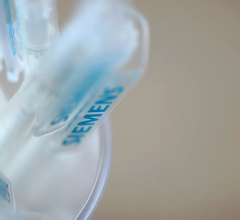
RFID tagged cath lab inventory being scanned in for use in a procedure at Nebraska Medicine's Bellevue Hospital. Automated systems like this can help eliminate or reduce the need for manual counts and enable more easily accessible analytics for better business management.
Tracking cardiovascular device inventory in cath labs, electrophysiology (EP) labs and operating rooms (ORs) can be a very time-consuming, tedious process using manual counts of what is on the shelves. As cardiovascular service lines look to improve workflow efficiencies and curb costs, automated inventory tracking systems may offer a solution.
Users of these systems say they can reduce costs with better charge capture during procedures, help with loss prevention, and identify inventory that will expire soon. Analytics data from these inventory tracking systems also can show true procedural costs, help quantify items that are wasted and items that are rarely used to reduce inventory. Users can also identify multiple products that do the same thing, like vascular closure devices, to help reduce inventory by standardizing items on the shelves.
Another advantage of inventory tracking systems is the data they provide to help in negotiations with device vendors and tracking consignment inventory.
Types of Inventory Tracking Systems
These automated systems use either bar-code scanning or radiofrequency identification (RFID) tags. As inventory is delivered, staff needs to attach a bar code sticker (or use the bar codes the manufacturer already prints on its packaging) or an RFID tag sticker to each item. A reader is then used to verify the item registers properly prior to stocking the shelves.
RFID systems usually incorporate tag readers into storage cabinets used in the interventional lab or OR. These systems can perform an instant inventory check of everything currently in the cabinet, or can automatically read when specific items are removed. This is recorded in an automated, digital log that can be used to track items pulled out during a procedure, which can help with ensuring all items are billed to a patient, or to track wastage items. The system also can help track down when items disappeared from a room and correlate it to who used a key card to access doors in the area at that time. This can help with loss prevention when physicians may borrow items from one hospital to use at another they work at. It can help track “borrowed” items taken by other departments, to ensure the lab or OR is not left holding the bill for these items.
RFID tags also can be scanned using a hand-held reader wand, or a reader panel installed at workstations, where a staff member can just hold the item next to the panel and it will be read. The wands can be waved over a table full of RFID tagged inventory to perform a fast count and recording of the items.
Barcode inventory systems require each item to be scanned individually as it is used so it registers in the system. Barcoding only works if the items are actually scanned for the log. If a staff member fails to scan an item, there is no tracking available for what happened to that inventory.
Experience Using an RFID System
Nebraska Medicine has three hospitals — Nebraska Medical Center as its main campus, Bellevue Community Hospital and the Village Pointe outpatient surgery center and clinics. The health system wants to unify all of its interventional labs (cardiac cath and interventional radiology), cardiac surgical ORs and hybrid ORs with a single, automated, RFID inventory management system. This includes a total of about 15 interventional labs. Bellevue became a test install site in March 2016 for a Cardinal Health Inventory Management Solutions (CIMS) that will soon be extended to all the labs and ORs across the system.
Prior to the new system, Bellevue used a bar-code scanning system and conducted manual counts. The manual counts tied up four to five staff members for seven hours, said Morgan Shradar, BSN, RN, manager, procedural services, pre-op/PACU, OR, GI, cath/IR, SPD, Bellevue. Today, she said all inventory counts are in real time using the automated RFID system.
“At first we had issues with the RFID cabinets not reading all the inventory, until we realized we had way too much product for the cabinet to be able to read the tags,” Shradar said. “That forced us to go back and review how much inventory we really needed. You don’t need 50 of one item, you might only need 10, so you can keep some in back stock on shelves outside of the cath lab and you can figure out how to reduce your inventory to what you really need.”
She said the hospital rapidly learned how to right-size its inventory based on analytics from what they were actually using. This helped streamline how much product they needed to keep on hand, and how and when they needed to re-order items.
“It allows a great relationship between supply and the cath lab staffs. Everyone can now log into the system and see the data. Before it was always someone else’s fault for why a lab did not have the supplies they needed when they had a patient in the lab,” Shradar said. Now, the cath lab staff can see exactly what they have on hand, what they are using and what needs to be re-ordered, and they have become more involved in the supply chain process, she explained. This has resulted in positive feedback from the doctors.
“I am not hiding anything from my providers, so sometimes we can look at what they are using and I can show them what products they are not using,” Shradar said.
For managing expiration dates, Bellevue’s inventory system can show all the expiration dates and where these products are located. Shradar said this allows them to transfer some older items to other sites where they will be used more readily. Bellevue also sets alerts for reports showing lists of what products are set to expire in 180 days or less.
Barcoding to Boost Business Analytics
Orlando Health operates six hospitals in the Orlando, Fla. region, which include 14 cardiac cath labs, four dedicated electrophysiology labs, three hybrid ORs and three dedicated interventional radiology labs. The health system used the inventory tracking capabilities of their two hemodynamic system vendors, but wanted to capture that data in one location using their cardiovascular information system (CVIS). In 2011, the system unified all their lab inventory data using the inventory management capability of the CVIS. The bar-code scanning-based inventory management system now captures data analytics in an easy-to-access and use format for better business intelligence and service line management.
“This system has allowed us to easily determine which products we are using across the health system,” said Paula Gadson, cardiology supply chain manager at Orlando Regional Medical Center, Orlando Health. “We found in some instances there is a big difference between what we ordered and what we actually need.”
The bar-coding system is much more efficient than relying on use of manual counts, handwritten or sticker log systems, Gadson explained. They use the barcodes that vendors print on their products. If there is no barcode, they create preference cards utilizing the catalog number as the barcode, or the staff manually searches for the catalog number in the system.
She said the system has helped with efforts to standardize inventory. With the old system, each facility used different nomenclatures for the same product. The centralized system uses a structured list of products with a standardized nomenclature, which helped create an apples-to-apples comparison between each facility. Also, the old system required Gadson and others to gather information from several people so it could be combined into one usage report, which was inefficient and time-consuming. Analytics also helped open the eyes of many staff members when they could track what they were actually using.
“We use the analytics from the inventory system to determine suitable par levels. In some instances, we have been able to reduce the amount of product on our shelves,” Gadson said. “For us, it was important that the system provided useful information so we could make wise decisions.”
Additionally, she said data is used to help track waste and the reason for the waste. She said analytics showed some staff were prone to open items prior to a procedure that the physician they were working with commonly used. However, the data suggested a percentage of the pre-opened items were not being used, which prompted change. Supply use and waste reports are now provided and reviewed each month.
For any hospital looking to adopt an inventory management system, Gadson said the key requirement is to keep in mind the ultimate goal of the service line and the organization. Inventory is just one component of the analytics needed to achieve excellent patient outcomes, she said, and the CVIS system provides a repository for everything cardiology. She also suggested that staff needs to be fully trained in how the system works and how accurate documentation directly impacts other things, such as supply cost, supply availability and reimbursement. The analytics are only as good as the data being entered.
Rick Jones, manager of business support systems, Orlando Health, said it is important that any inventory management system integrates with the hospital charge capture and supply management systems. Also, data is much easier to manage if the number of sources from various systems is reduced. “Integration is key," Jones said. “Before, we ran charges with our accounts management system, which could be a little dicey, but now all the data is easy to access in a central location.”
Another suggestion from Gadson is to find a physician champion and super-users at each site where a new inventory system will be implemented. She said that makes it a lot easier to achieve staff buy-in and makes for an easier implementation.
The analytics data also is used by the health system’s Medical Equipment Outcomes Committees, which review and approve all new product requests. Those decisions, combined with inventory analytics and close collaboration corporate supply chain management, are utilized to develop purchasing strategies. This enables a readily available supply of devices without the need to store all the items at individual facilities.
The inventory tracking system enables real-time tracking of what each lab has on hand and simplifies and streamlines the reordering process, Gadson explained. “Since our inventory management system is now interfaced with our supply ordering system, the amount of time it takes to re-order supplies has significantly been reduced,” she said.
Comparison Chart of Cardiology Inventory Management Systems
DAIC has created a comparison chart of specifications for inventory tracking systems used in the cath lab, EP lab or cardiovascular OR. It can be accessed at
https://www.dicardiology.com/content/inventory-management. It will require a login, but it is free and only takes a minute. The chart includes the vendors Cardinal Healthcare, Lumedx, McKesson, Philips Healthcare and Stanley Healthcare.
Additional Inventory Management Resources:
Read the article “Advances in Cath Lab Inventory Control Systems.”
Read the article “Advanced Analytics Software for Cardiology.”


 November 14, 2025
November 14, 2025 









